Physical Address
304 North Cardinal St.
Dorchester Center, MA 02124
Physical Address
304 North Cardinal St.
Dorchester Center, MA 02124
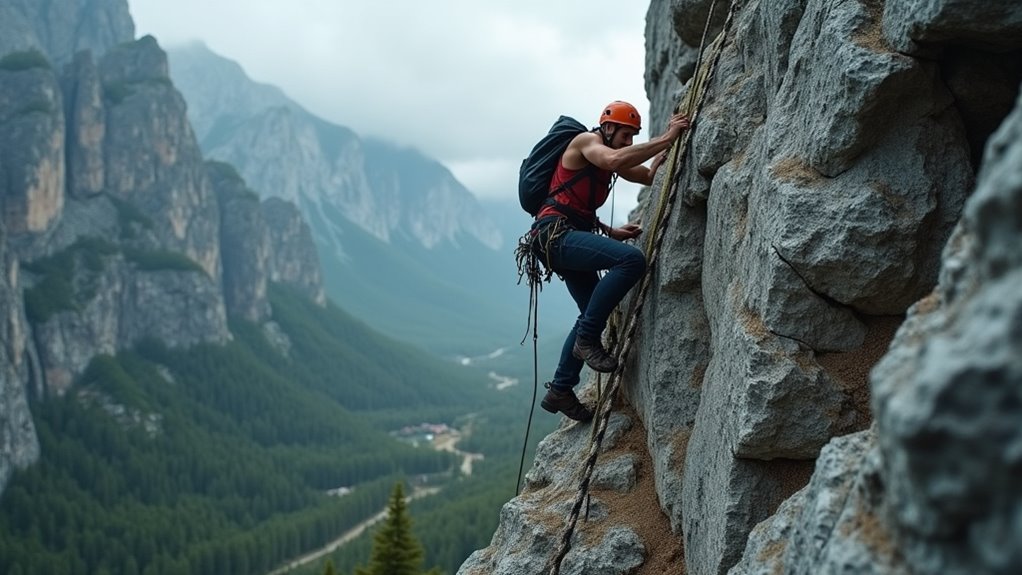
Just when you think you've mastered the basics, these thirteen climbing dangers could turn your next adventure into a life-threatening situation.
You’ve probably heard that climbing is dangerous, but you might not realize just how many ways things can go wrong on the rock face. From equipment failures that happen without warning to sudden weather changes that can trap you mid-route, the mountains don’t forgive poor preparation or bad luck. Understanding these thirteen critical dangers isn’t meant to scare you away from climbing—it’s about recognizing what you’re up against so you can climb smarter and safer.
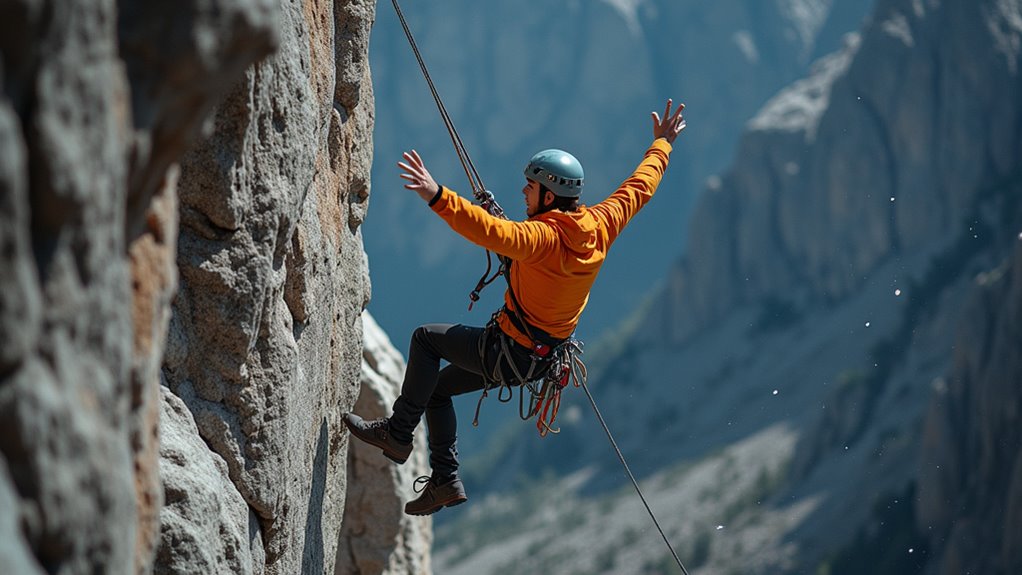
When you’re scaling a rock face or maneuvering a challenging route, falling represents the most immediate and serious threat you’ll face as a climber. Ground falls can result in broken bones, head injuries, and internal damage that’ll end your climbing career permanently.
Even shorter falls onto ledges or protruding rocks create devastating impact forces.
Your body wasn’t designed to absorb sudden stops from height. Ankles, wrists,, and spines bear the brunt of impact trauma. Head injuries remain particularly dangerous since they can cause immediate unconsciousness or long-term cognitive damage.
Proper protection systems reduce fall distances, but they can’t eliminate injury risks entirely. Always inspect your gear, practice falling techniques, and climb within your skill level to minimize these life-threatening dangers.
Just like choosing between renting or buying a boat for your fishing adventures, selecting the right climbing gear requires careful consideration of your experience level and frequency of use.
Since your life depends on the integrity of every piece of gear you carry, equipment failure poses one of climbing’s most insidious threats. Unlike obvious hazards, gear malfunction strikes without warning when you need protection most.
Your rope can suffer hidden damage from sharp edges or UV exposure, weakening its strength profoundly. Carabiners may develop hairline cracks that aren’t visible during casual inspection. Harnesses can fail at stress points after years of use, and worn webbing on quickdraws becomes increasingly unreliable.
Regular gear inspection is vital—check for fraying, corrosion, and wear patterns before every climb. Replace equipment according to manufacturer guidelines, not your budget. Consider retiring gear after major falls, even if damage isn’t apparent. Remember, the cheapest piece of gear is your most expensive when it fails.
Many camping enthusiasts who combine rock climbing with their outdoor adventures face additional challenges in maintaining gear condition due to extended exposure to elements and limited storage options.
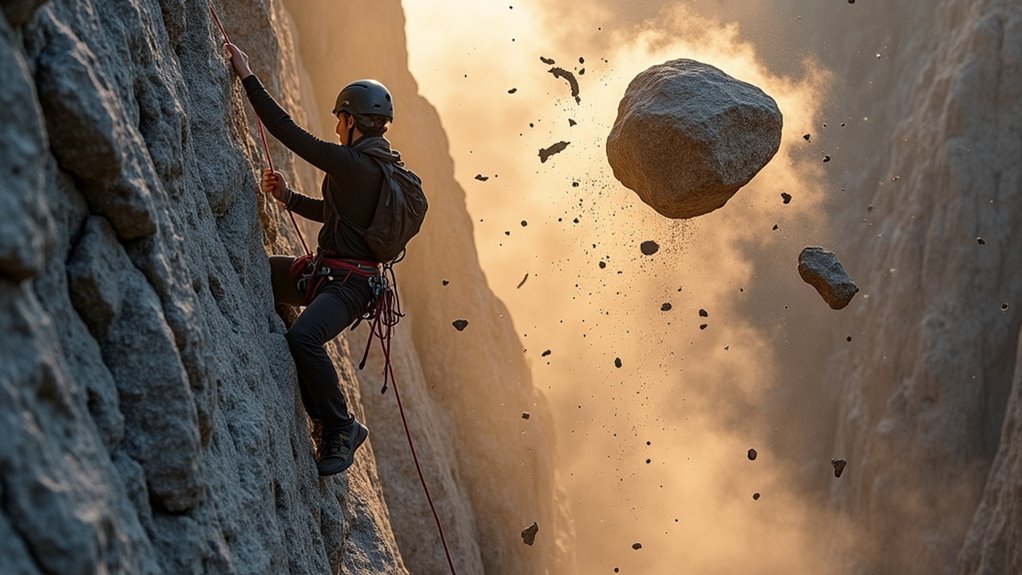
While you’re focused on your next hold, gravity works relentlessly above you to dislodge rocks that can strike without warning. Rockfall poses one of climbing’s most unpredictable dangers, especially on popular routes where loose debris accumulates from repeated traffic.
You’ll face higher risks during freeze-thaw cycles when expanding ice weakens rock bonds, and after storms when water lubricates fractures. Listen for the telltale sound of falling stones and always wear a helmet – it’s your primary defense against head injuries.
When climbing in groups, maintain proper spacing to avoid knocking rocks onto partners below. Test holds before committing your full weight, and communicate immediately when you dislodge anything.
Choose established routes over loose, unclimbed rock faces whenever possible. Just as water sports require proper safety protocols and equipment, climbing demands constant vigilance and adherence to established safety practices to minimize risks.
As storm clouds gather overhead, you’re exposed on vertical terrain with nowhere to run for cover. Lightning strikes the highest points first, making you a prime target on cliff faces and ridges. Weather can change rapidly in mountains, turning a sunny climb into a life-threatening situation within minutes.
You’ll face reduced visibility, slippery rock surfaces, and hypothermia risks when temperatures drop. High winds can knock you off balance or make rappelling dangerous. If you hear thunder, you’re already in the strike zone – lightning travels faster than sound.
Check weather forecasts before climbing and watch for developing storms. Start early to avoid afternoon thunderstorms. If caught in severe weather, find the lowest terrain possible, avoid metal gear, and wait it out rather than continuing your ascent. Consider bringing a lightweight jungle hammock as emergency shelter that can be quickly deployed between trees at lower elevations when seeking immediate cover from severe weather.
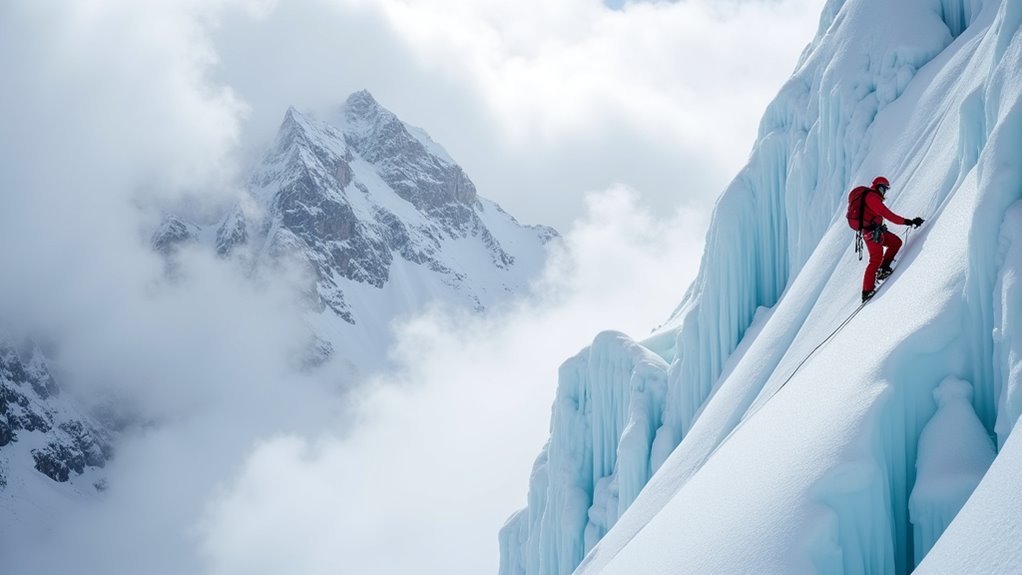
Snow-covered peaks may look serene, but they’re hiding one of climbing’s deadliest threats. Avalanches can bury you within seconds, and unstable snow conditions turn routine ascents into death traps.
You’ll need avalanche education before tackling winter climbs. Learn to read terrain, weather patterns, and snowpack layers. Carry essential gear: beacon, probe, and shovel. Check avalanche forecasts religiously and know how to dig snow pits to assess stability.
Watch for warning signs like recent snowfall, wind loading, and temperature changes. Avoid steep slopes during high-risk periods.
If you’re caught in an avalanche, try swimming motions to stay on top, then create an air pocket before the snow settles.
Your survival depends on preparation, knowledge, and respect for mountain conditions. Just like family camping requires careful planning and preparation, mountain climbing demands thorough preparation to ensure everyone returns home safely.
When you ascend beyond 8,000 feet, your body enters a battle against diminishing oxygen levels that can quickly turn dangerous. Altitude sickness affects climbers differently, but you’ll typically experience headaches, nausea, dizziness, and fatigue as initial warning signs. Don’t ignore these symptoms—they’re your body’s alarm system.
Your body’s headaches, nausea, and dizziness at high altitude aren’t just discomfort—they’re urgent warnings you must heed.
As you climb higher, you risk developing High Altitude Pulmonary Edema (HAPE) or High Altitude Cerebral Edema (HACE), both potentially fatal conditions. HAPE fills your lungs with fluid, while HACE causes brain swelling.
You can prevent altitude sickness by ascending gradually, staying hydrated, and listening to your body. If symptoms worsen, descend immediately—it’s the only guaranteed cure.
Consider acetazolamide (Diamox) for prevention, but consult your doctor first. Having the right camping backpack ensures you can carry essential altitude sickness medications and emergency supplies efficiently during your ascent.

Cold temperatures pose one of climbing’s most insidious threats because hypothermia can sneak up on you without warning. Your body temperature drops when you can’t generate enough heat to compensate for what you’re losing. Early signs include uncontrollable shivering, confusion, and poor coordination—dangerous symptoms when you’re steering through technical terrain.
You’re at higher risk when you’re wet, exhausted, or inadequately dressed. Wind amplifies heat loss dramatically, making conditions feel much colder than the actual temperature. Frostbite can develop simultaneously, damaging your fingers and toes within minutes in extreme conditions.
Prevention’s your best defense: dress in moisture-wicking layers, carry emergency shelter, and recognize early symptoms. If hypothermia sets in, seek immediate shelter, remove wet clothing, and warm your core gradually. These risks are particularly relevant on exposed routes like Scotland’s West Highland Way, where weather conditions can change rapidly at elevation.
Even experienced climbers can find themselves disoriented when familiar landmarks disappear behind clouds or darkness falls faster than expected. Getting lost on a mountain can quickly turn dangerous, especially when weather deteriorates or daylight fades.
Mountain disorientation strikes even seasoned climbers when clouds obscure landmarks or darkness arrives unexpectedly, transforming routine ascents into potentially life-threatening situations.
You’ll reduce your risk by studying your route thoroughly before climbing and carrying detailed maps, compass, and GPS device. Don’t rely solely on technology—batteries die and devices break. Learn to read terrain features and practice navigation skills regularly.
If you do get lost, stop immediately. Don’t panic or continue blindly hoping to find your way. Assess your position carefully, conserve energy, and consider turning back if conditions worsen. Mark your location and stay put if rescue becomes necessary.
Poor visibility makes route-finding errors more likely, so adjust your timeline accordingly. When setting up camp during extended climbs, implement effective strategies to keep mosquitoes away since these insects can disrupt sleep and concentration needed for safe navigation the following day.
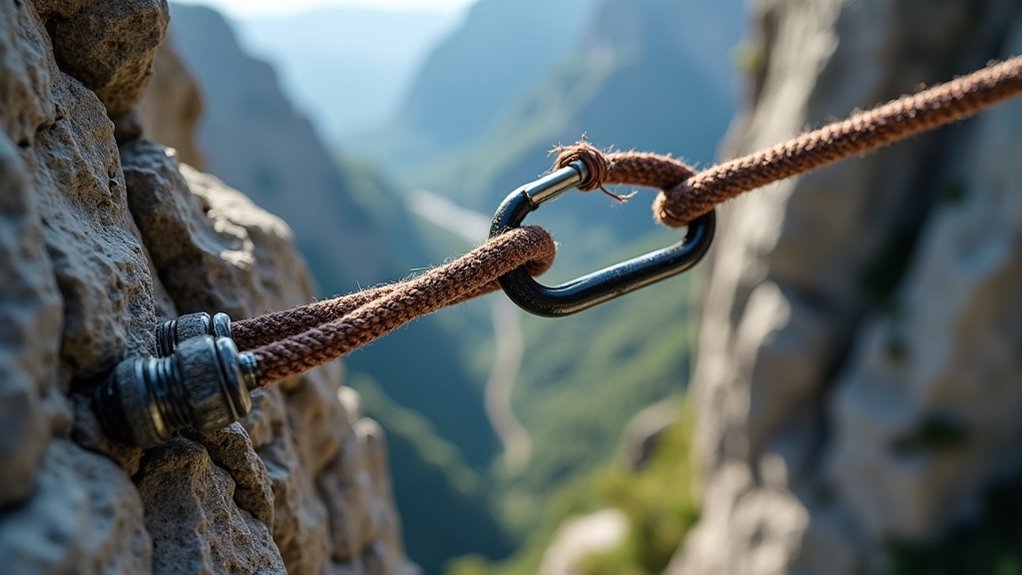
Rappelling accidents rank among the most serious climbing incidents, often resulting from equipment failure, human error, or faulty anchor systems. You’re trusting your life to anchors that might’ve been compromised by weather, rockfall, or previous climbers’ mistakes.
Always inspect existing anchors thoroughly before rappelling. Look for worn webbing, loose bolts, or cracked rock around placements. Don’t assume previous climbers set reliable anchors—they might’ve been rushed or inexperienced.
Double-check your rappel device setup and ensure you’re threaded correctly. Use a backup like an autoblock below your device. Test your system with body weight before committing fully.
Consider building redundant anchors when possible. Two independent anchor points reduce your risk considerably. Remember, you can’t undo a rappelling mistake once you’re committed to descending.
When planning your next outdoor adventure, consider incorporating camping activities that don’t involve technical climbing to balance risk and enjoyment.
While technical failures pose immediate threats, your body’s gradual breakdown from dehydration and heat exhaustion can be equally dangerous during long climbing sessions. You’ll lose fluids through sweat and breathing at altitude, often without realizing it.
Early signs include headaches, dizziness, and decreased grip strength—all critical when you’re on the rock.
Pack more water than you think you’ll need, and drink regularly before you feel thirsty. Light-colored, loose clothing helps regulate body temperature better than dark, tight gear.
Start climbs early to avoid peak heat, and take breaks in shade when possible.
Watch your climbing partners for confusion, nausea, or excessive fatigue—these signal serious heat illness requiring immediate descent and medical attention.
Consider bringing a portable espresso maker to quickly prepare coffee during rest breaks, as caffeine can help maintain alertness and focus during challenging climbs.
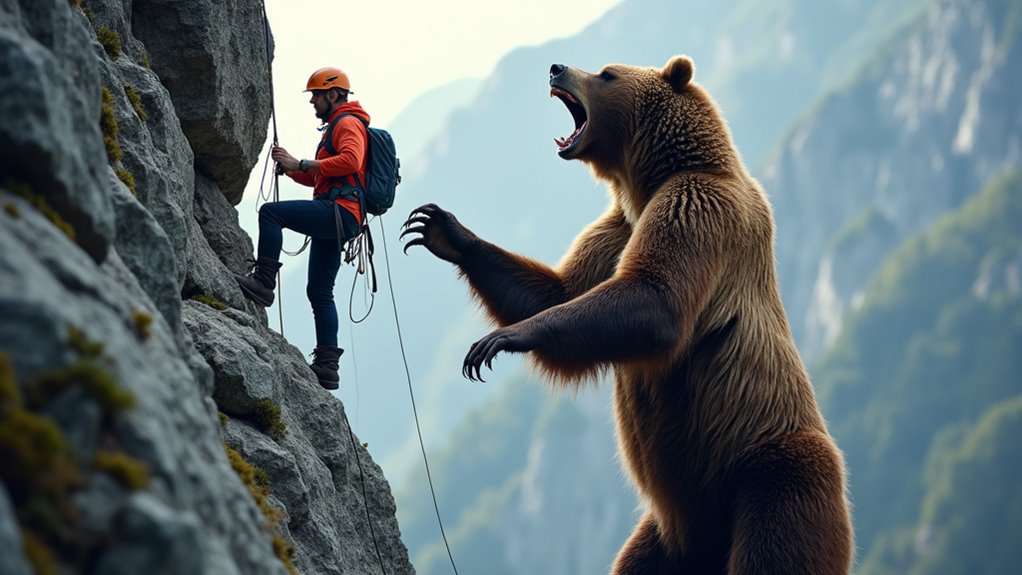
When you’re focused on your next hold, it’s easy to forget that climbing routes often cut through prime wildlife habitat where bears, mountain lions, venomous snakes, and aggressive birds make their homes. These encounters can turn deadly fast.
Before climbing, research local wildlife patterns and seasonal behaviors. Bears are most active during dawn and dusk, while snakes bask on sunny rock faces. Make noise while approaching routes to avoid surprising animals, and always check ledges and cracks before placing your hands.
If you encounter a predator, don’t run or make sudden movements. Back away slowly while maintaining eye contact with mountain lions, but avoid direct eye contact with bears. Carry bear spray in accessible locations, and know how to use it effectively before you need it.
When establishing your base camp, apply proper campsite selection principles to minimize wildlife encounters by avoiding areas near water sources, game trails, and obvious animal feeding grounds.
Beyond external threats from wildlife, the most preventable climbing accidents stem from miscommunication between partners and simple human mistakes. You’ll face serious risks when commands aren’t clearly understood – “off belay” versus “on belay” confusion has caused fatal falls. Always establish clear communication protocols before starting your climb and repeat commands back to confirm understanding.
Human error compounds these dangers. You might forget to double-check knots, clip into the wrong anchor point, or rappel off rope ends. Fatigue and complacency increase mistake frequency, especially on familiar routes where you think you can’t go wrong.
Combat these risks by implementing redundant safety checks. Have your partner verify your knots, harness, and gear setup. Stay alert, communicate constantly, and never assume anything during your climb. Mastering essential techniques for belaying, anchoring, and rope management creates multiple layers of protection against both communication failures and human error.
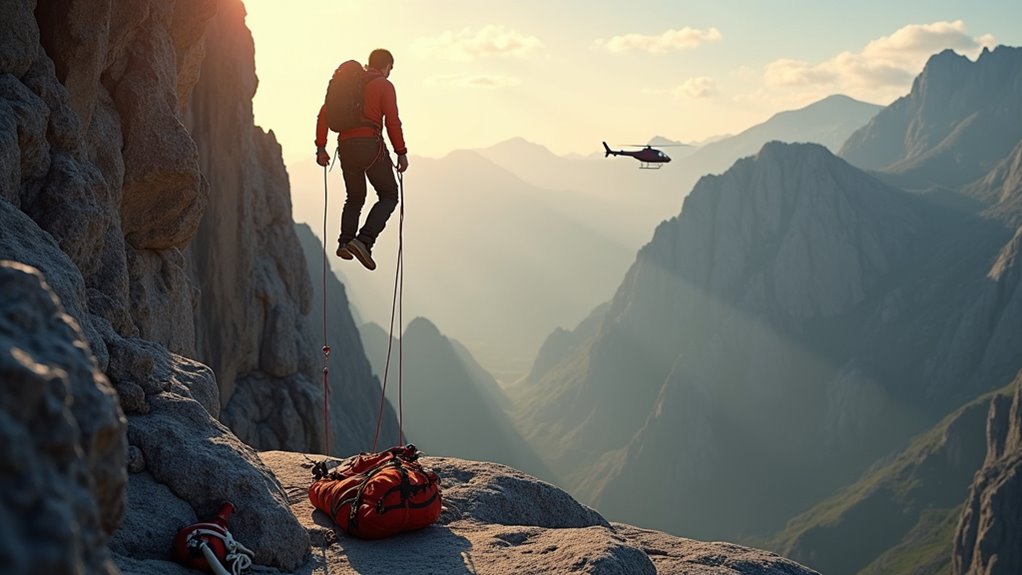
Medical emergencies become exponentially more dangerous when you’re hours or even days away from professional help. A simple ankle sprain that’d be inconvenient in town becomes a serious evacuation scenario on a remote cliff face. You’ll need thorough first aid training and a well-stocked medical kit tailored for climbing injuries.
Common emergencies include head injuries from rockfall, broken bones from falls, hypothermia, altitude sickness, and severe cuts from sharp rock. Your response time matters—delayed treatment can turn manageable injuries into life-threatening situations.
Always carry communication devices like satellite messengers or personal locator beacons. Know your exact coordinates and have evacuation plans ready. Practice self-rescue techniques and ensure someone knows your climbing itinerary. Sometimes you’ll be your own first responder.
When planning your climbing adventures, consider attending Britain’s Motorhome Show to explore mobile basecamp options that can keep you closer to remote climbing areas while maintaining access to medical supplies and communication equipment.
Climbing’s inherent risks don’t have to end your adventure before it starts. You’ve learned about the major hazards—from equipment failures to wildlife encounters—but knowledge is your best defense. Will you let fear paralyze you, or will you use this information to climb smarter? Double-check your gear, monitor weather conditions, communicate clearly with your partner, and always have an emergency plan. Respect the mountain, prepare thoroughly, and you’ll maximize your chances of returning home safely.